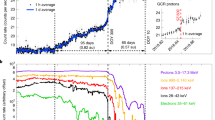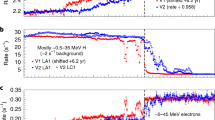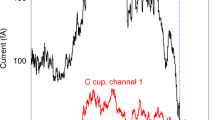Abstract
The heliopause is a boundary that separates the heliosheath (which contains magnetic fields and plasmas that originate in the Sun) from the interstellar medium (which contains magnetic fields and particles of stellar/interstellar origin). Observations of the heliopause were first made by the particles and fields instruments on the Voyager 1 spacecraft, moving radially in the northern hemisphere, which crossed the heliopause on 25 August 2012 at a distance of 121.6 au. We show using observations of the magnetic field and energetic particles that Voyager 2 crossed the heliopause in the southern hemisphere on 5 November 2018 at a distance of ≈119.0 au. Voyager 2 observed a much thinner and simpler heliopause than Voyager 1 as well as stronger interstellar magnetic fields, and it discovered a ‘magnetic barrier’ in the heliosheath adjacent to the heliopause that strongly influences the entry of cosmic rays into the heliosphere. The magnetic field direction observed by Voyager 2 changed smoothly from the time of arrival at the magnetic barrier, through it, and onwards into the interstellar medium, with a small (a few degrees) or no change across the heliopause. These observations, together with the Voyager 1 observations and existing models, show that the magnetic barrier, the heliopause and the neighbouring very local interstellar medium form a complex interconnected dynamical system.
This is a preview of subscription content, access via your institution
Access options
Access Nature and 54 other Nature Portfolio journals
Get Nature+, our best-value online-access subscription
$29.99 / 30 days
cancel any time
Subscribe to this journal
Receive 12 digital issues and online access to articles
$119.00 per year
only $9.92 per issue
Buy this article
- Purchase on Springer Link
- Instant access to full article PDF
Prices may be subject to local taxes which are calculated during checkout






Similar content being viewed by others
Data availability
The 48 s averages of the magnetic field data are posted on NASA’s Space Science Data Facility (SPDF) CDAWeb site: https://cdaweb.gsfc.nasa.gov/index.html/. The hour averages of the magnetic field data are posted on NASA’s Space Science Data Facility (SPDF) COHOWeb site https://omniweb.sci.gsfc.nasa.gov/coho/.
References
Davis, L. Interplanetary magnetic fields and cosmic rays. Phys. Rev. 100, 1440–1444 (1955).
Parker, E. N. The stellar-wind regions. Astrophys. J. Lett. 134, 20–27 (1961).
Holzer, T. E. Interaction of the solar wind with the neutral component of the interstellar gas. J. Geophys. Res. 77, 5407–5431 (1972).
Baranov, V. B., Krasnobarev, K. V. & Ruderman, M. S. On the model of the solar wind-interstellar medium interaction with two shock waves. Astrophys. Space Sci. 41, 481–490 (1976).
Holzer, T. Interaction between the solar wind and the interstellar medium. Annu. Rev. Astron. Astrophys. 27, 199–234 (1989).
Zank, G. P. Faltering steps into the Galaxy: the boundary regions of the heliosphere. Annu. Rev. Astron. Astrophys. 53, 449–500 (2015).
Burlaga, L., Ness, N. F. & Stone, E. C. Magnetic field observations as Voyager 1 entered the heliosheath depletion region. Science 341, 148–150 (2013).
Gurnett, D. A., Kurth, W. S., Burlaga, L. F. & Ness, N. F. In situ observations of interstellar plasma with Voyager 1. Science 341, 1489–1492 (2013).
Krimigis, S. M. et al. Search for the exit: Voyager 1 at heliosphere’s border with the galaxy. Science 341, 144–147 (2013).
Stone, E. C. et al. Voyager 1 observes low-energy galactic cosmic rays in a region depleted of heliospheric ions. Science 341, 150–153 (2013).
Grygorczuk, J. A., Czechowski, A. & Grzedzielski, S. Why are the magnetic field directions measured by Voyager 1 on both sides of the heliopause so similar? Astrophys. J. Lett. 789, L43–L46 (2014).
Schwadron, N. A. & McComas, D. J. Effects of solar activity on the local interstellar magnetic field observed by Voyager 1 and IBEX. Astrophys. J. 849, 135–145 (2017).
Pogorelov, N. V. et al. Three-dimensional features of the outer heliosphere due to coupling between the interstellar and heliospheric magnetic field. V. The bow wave, heliospheric boundary layer, instabilities, and magnetic reconnection. Astrophys. J. 845, 9 (2017).
Burlaga, L. F. & Ness, N. F. Voyager 1 observations of the interstellar magnetic field and the transition from the heliosheath. Astrophys. J. 784, 146–160 (2014).
Burlaga, L. F. & Ness, N. F. Interstellar magnetic fields observed by Voyager 1 beyond the heliopause. Astrophys. J. Lett. 795, L19–L23 (2014).
Borovikov, S. N. & Pogorelov, N. V. Voyager 1 near the heliopause. Astrophys. J. Lett. 783, L16–L21 (2014).
Pogorelov, N. V. et al. Unsteady processes in the vicinity of the heliopause: are we in the LISM yet? AIP Conf. Proc. 1539, 352–355 (2013).
Pogorelov, N. V. et al. Radial velocity along the Voyager 1 trajectory: the effect of solar cycle. Astrophys. J. Lett. 750, L4–L10 (2012).
Whang, Y. C. Interstellar magnetic field surrounding the heliopause. Astrophys. J. 710, 936–940 (2010).
Opher, M. et al. A strong, highly-tilted interstellar magnetic field near the solar magnetic field. Nature 462, 1036–1038 (2009).
Opher, M., Drake, J. F., Swisdak, M., Zieger, B. & Toth, G. The twist of the draped interstellar magnetic field ahead of the heliopause: a magnetic reconnection driven rotational discontinuity. Astrophys. J. 839, L12–L18 (2017).
Behannon, K. et al. Magnetic field experiment for Voyagers 1 and 2. Space Sci. Rev. 21, 235–257 (1977).
Berdichevsky, D. B. Voyager Mission, Detailed Processing of Weak Magnetic Fields; Constraints to the Uncertainties of the Calibrated Magnetic Field Signal in the Voyager Missions https://go.nature.com/2owpT0w (2009).
Burlaga, L. F. Interplanetary Magnetohydrodynamics (Oxford Univ. Press, 1995).
Nerney, S., Suess, S. T. & Schmahl, E. J. Flow downstream of the heliospheric terminal shock—magnetic field kinematics. Astron. Astrophys. 250, 556–564 (1991).
Nerney, S., Suess, S. T. & Schmahl, E. J. Flow downstream of the heliospheric terminal shock: the magnetic field in the heliopause. J. Geophys. Res. 98, 15169–15176 (1993).
Washimi, H. & Tanaka, T. 3-D magnetic field and current system in the heliosphere. Space Sci. Rev. 78, 85–94 (1996).
Washimi, H., Zank, G. P., Hu, Q., Tanaka, T. & Munakata, K. MHD modeling of the outer heliospheric structures around the heliopause. Astrophys. J. 809, 16–28 (2015).
Washimi, H., Hu, Q., Tanaka, T., Munakata, K. & Shinagawa, H. Realistic and time-varying outer heliospheric modelling. Mon. Not. R. Astron. Soc. 416, 1475–1485 (2011).
Drake, J. F., Swisdak, M., Opher, M. & Richardson, J. D. The formation of magnetic depletions and flux annihilation due to reconnection in the heliosheath. Astrophys. J. 837, 159 (2017).
Burlaga, L. F., Ness, N. F., Gurnett, D. A. & Kurth, W. S. Evidence for a shock in interstellar plasma: Voyager 1. Astrophys. J. Lett. 778, L3 (2013).
Burlaga, L. F. et al. A magnetic pressure front upstream of the heliopause, and the heliosheath magnetic fields and plasma, observed during 2017. Astrophys. J. Lett. 877, 31 (2019).
Berdichevsky, D. B. Voyager Mission, Detailed Processing of Weak Magnetic Fields; II- Update on the Cleaning of Voyager Magnetic Field Density B with MAGCALs https://go.nature.com/2mTk8t8 (2015).
Stone, E. C., Cummings, A. C., Heikkila, B. C. & Lal, N. Cosmic ray measurements from Voyager 2 as it crossed into interstellar space. Nat. Astron. https://doi.org/10.1038/s41550-019-0928-3 (2019).
Acknowledgements
L.F.B., N.F.N., D.B.B., J.P., L.K.J. and A.S. were supported by the NASA Voyager Project to the NASA/GSFC Magnetometer Team under internal NASA funding. L.K.J. is grateful for support from The International Space Science Institute in Bern in the framework of the team ‘The Physics of the Very Local Interstellar Medium’. L.F.B. thanks N. Pogorelov and H. Washimi for helpful discussions, and N. Pogorelov for preparing Fig. 5. J.D.R. was supported by NASA under grant number 959203 from the Jet Propulsion Laboratory to the Massachusetts Institute.
Author information
Authors and Affiliations
Contributions
L.F.B. wrote the initial draft of the manuscript, incorporated contributions from the other authors, compiled and submitted the final paper, prepared the final edited datasets, and submitted the data to the NASA archives. N.F.N. is the principal investigator of the magnetic field investigation. D.B.B. calibrated the magnetic field data. J.P. and L.K.J. assisted in data calibrations and made contributions to the paper. A.S. managed the data processing and the budget. J.D.R. provided the plasma data and contributed to their interpretation. E.C.S. provided the cosmic ray data and >0.5 MeV data and contributed to the interpretation of the data.
Corresponding author
Ethics declarations
Competing interests
The authors declare no competing interests.
Additional information
Publisher’s note Springer Nature remains neutral with regard to jurisdictional claims in published maps and institutional affiliations.
Rights and permissions
About this article
Cite this article
Burlaga, L.F., Ness, N.F., Berdichevsky, D.B. et al. Magnetic field and particle measurements made by Voyager 2 at and near the heliopause. Nat Astron 3, 1007–1012 (2019). https://doi.org/10.1038/s41550-019-0920-y
Received:
Accepted:
Published:
Issue Date:
DOI: https://doi.org/10.1038/s41550-019-0920-y
This article is cited by
-
Future Exploration of the Outer Heliosphere and Very Local Interstellar Medium by Interstellar Probe
Space Science Reviews (2023)
-
Oblique and rippled heliosphere structures from the Interstellar Boundary Explorer
Nature Astronomy (2022)
-
Observations of the Outer Heliosphere, Heliosheath, and Interstellar Medium
Space Science Reviews (2022)
-
Turbulence in the Outer Heliosphere
Space Science Reviews (2022)
-
The Structure of the Large-Scale Heliosphere as Seen by Current Models
Space Science Reviews (2022)



